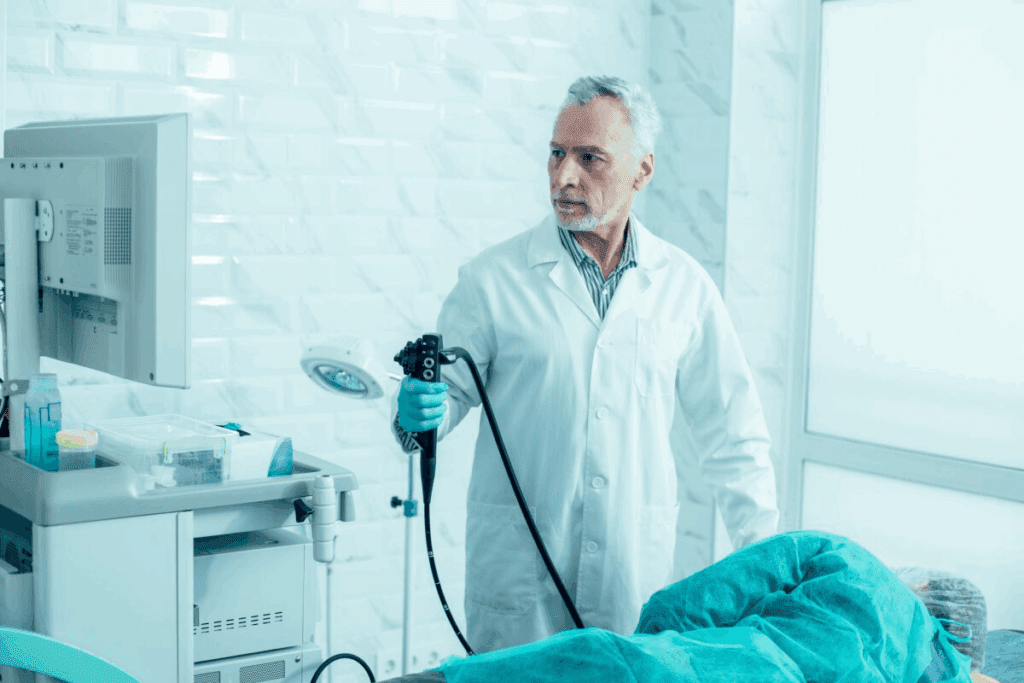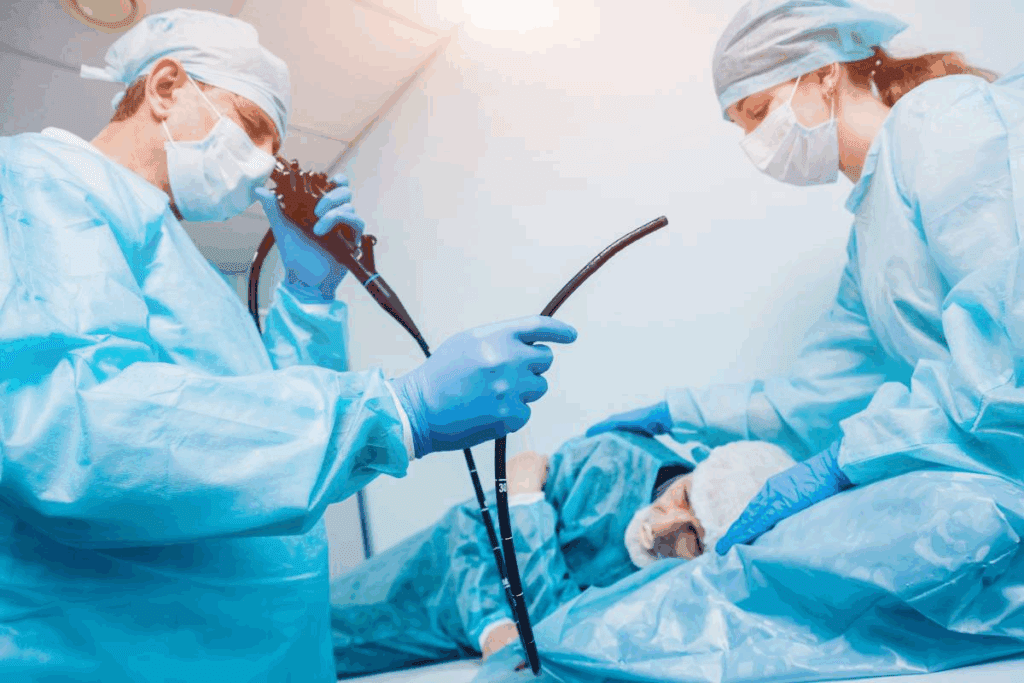Last Updated on November 26, 2025 by Bilal Hasdemir

A colonoscopy is a key test that looks at the inside of the colon and rectum. Find out what does a colonoscopy show and which diseases or conditions it can help detect early.
It’s seen as the top choice for colorectal cancer screening and finding out if you have it. This test can spot and take out growths that could turn into cancer. It helps lower the chance of cancer and can save lives.
Liv Hospital has top-notch colonoscopy services. They follow the newest medical rules to make sure care is safe and focused on the patient. They help find important diseases.

Colonoscopy is a key tool for doctors to see inside the colon and rectum. It helps find problems in the lower part of the digestive system.
A colonoscopy uses a flexible tube with a camera to look at the colon and rectum. It’s important for spotting issues like polyps, cancer, and inflammatory bowel diseases.
The procedure is significant because it can find and remove polyps before they turn into cancer. The American Cancer Society says regular screenings can lower the risk of colorectal cancer.
Doctors suggest a colonoscopy for several reasons:
A gastroenterologist says, “Colonoscopy is a vital tool against colorectal cancer and other GI issues.”
“Colonoscopy has changed how we diagnose and treat colon and rectal problems, giving us a new view into the lower GI tract.”
Gastroenterology Expert
The colonoscopy process includes several steps:
After the procedure, patients are watched until the sedation wears off. They can usually go back to normal activities the next day.

A colonoscopy is a key tool for doctors to see inside the colon and rectum. It lets them check for different problems and issues.
Doctors can look at the colon and rectum’s lining during a colonoscopy. The camera on the colonoscope shows them any issues. Dr. John Smith, a gastroenterologist, says,
“Colonoscopy has changed how we find and treat colon problems.”
Colonoscopy can spot many issues, like polyps, cancer, IBD, and diverticular disease. Colon polyps are growths that can turn into cancer. It also finds signs of IBD, like ulcers and inflammation.
Finding these problems early is key. For example, removing polyps can stop cancer. Diagnosing IBD helps doctors create the right treatment plan.
Doctors might take biopsies during a colonoscopy. These are small tissue samples for more checks. Biopsies help figure out if a polyp or lesion is cancerous or not.
The American Cancer Society says, “Biopsies from colonoscopy are vital for knowing if a polyp or lesion is cancerous or not.”
Colon polyps come in different types and have varying risks for colorectal cancer. These growths can be harmless, precancerous, or cancerous. Knowing about them is key to managing and preventing cancer.
Benign colon polyps are not cancerous and don’t spread. They are often found during colonoscopies. Removing them can prevent problems. Hyperplastic polyps are usually small and not cancerous.
Removing benign polyps during a colonoscopy, called polypectomy, is important. It stops bleeding and checks if the polyp is harmless.
Precancerous polyps, like adenomatous polyps, can turn into cancer if not removed. Their risk depends on size, type, and how abnormal they are. Big or abnormal polyps are more risky.
Removing these polyps during a colonoscopy is vital. Polyp removal cuts down cancer risk by stopping these polyps from becoming cancerous.
Removing precancerous polyps lowers cancer risk. Colonoscopies with polyp removal can cut cancer risk by up to 90%. This shows how important regular screenings and early action are.
Understanding colon polyps helps see why colonoscopies are key in preventing cancer. Regular screenings and removing precancerous polyps are essential for early detection and prevention.
Colonoscopy has changed how we treat cancer. It lets doctors see the colon and rectum directly. This helps find cancer early on.
Doctors can spot early signs of colorectal cancer during a colonoscopy. They look for small, flat lesions or polyps that might be cancerous. Finding these early is key to treating the cancer well.
Early-stage colorectal cancer often doesn’t show symptoms. So, colonoscopy is key for catching it early.
Advanced colorectal cancer looks different. It’s bigger and might bleed or cause problems. Doctors check how far the cancer has spread to decide treatment.
Advanced cancer in the colon can look like big, irregular masses. It might block the colon or cause bleeding.
Finding cancer early greatly improves survival chances. Early detection means a much better five-year survival rate. People at risk should get regular colonoscopies.
Screening programs help a lot. They catch and remove polyps before they turn cancerous. This means finding cancer when it’s easier to treat.
Colonoscopy lets doctors see inside the colon to diagnose diseases. It’s key for spotting ulcerative colitis and Crohn’s disease early. This helps start the right treatment fast.
Ulcerative colitis causes ongoing inflammation in the colon. It starts at the rectum and goes up. Colonoscopy shows signs like:
Crohn’s disease can hit any part of the gut, but often targets the end of the ileum and colon. Colonoscopy might show:
Crohn’s disease has a more patchy look than ulcerative colitis.
Telling ulcerative colitis from Crohn’s disease is key for the right treatment. Here’s a table of differences seen during colonoscopy:
| Characteristics | Ulcerative Colitis | Crohn’s Disease |
| Extent of Inflammation | Continuous, starting from the rectum | Patchy, skip lesions |
| Depth of Inflammation | Mucosal layer | Transmural |
| Common Findings | Diffuse ulceration, pseudopolyps | Aphthous ulcers, cobblestoning, strictures |
Doctors can accurately diagnose and plan treatment by looking at colonoscopy results. This helps manage inflammatory bowel disease well.
Diverticular disease comes in two main types: mild and severe. It’s common in Western countries, affecting many people. The mild form, diverticulosis, involves small pouches in the colon wall. The severe form, diverticulitis, is an inflammation of these pouches.
Diverticulosis is when small pouches, called diverticula, form in the colon. These pouches are usually small and can be seen during a colonoscopy. It’s often found by accident during a screening colonoscopy.
This condition can turn into diverticulitis or cause bleeding. Risk factors include age, a low-fiber diet, and not being active.
Diverticulitis happens when the pouches get inflamed or infected. Symptoms can be mild or severe. They include pain in the lower left abdomen, fever, nausea, and changes in bowel habits.
Severe diverticulitis can cause abscesses, perforation, or fistulas. Doctors diagnose it based on symptoms and CT scans. Colonoscopy helps assess the severity and rule out other conditions.
Managing diverticular disease depends on its severity. For mild cases, like diverticulosis, doctors recommend a high-fiber diet and lifestyle changes.
For diverticulitis, treatment varies. Mild cases might get antibiotics and rest. Severe cases might need hospital care or surgery. Antibiotics treat the infection, and pain management is key.
Surgery might be needed for recurrent or severe cases. This involves removing part of the colon. The decision to operate depends on how often symptoms occur, their severity, and complications.
It’s important to understand the range of diverticular disease. Mild cases might just need diet changes, but severe cases need aggressive treatment. Colonoscopy is vital for diagnosing and assessing these conditions.
Colonoscopy can find more than just the main issues. It can spot hemorrhoids, sources of bleeding, and strictures. Each of these has its own signs and affects health differently.
Hemorrhoids are common and can be found during a colonoscopy. They are split into internal and external types. Internal ones are usually painless but can bleed. External ones can hurt and may get swollen.
Characteristics of Hemorrhoids:
Gastrointestinal bleeding is a serious issue that can be deadly. Colonoscopy is key in finding where the bleeding comes from. It could be from ulcers, abnormal blood vessels, or tumors.
| Source of Bleeding | Description |
| Ulcers | Open sores that can bleed, often due to NSAID use or infection. |
| Angiodysplasia | Abnormal blood vessels that can cause bleeding. |
| Tumors | Benign or malignant growths that can erode into blood vessels. |
Strictures are narrow spots in the colon or rectum caused by scar tissue or inflammation. They can cause constipation or pain. Colonoscopy can find and sometimes treat strictures by widening them.
Causes of Strictures:
Colonoscopy is a powerful tool for diagnosing many conditions. But, it has its limits. It mainly looks at the colon and rectum. There are some issues in the gut it can’t find.
Irritable Bowel Syndrome (IBS) causes pain, bloating, and changes in bowel movements. It doesn’t show up as inflammation or structural changes on a colonoscopy. So, doctors diagnose IBS by looking at symptoms and ruling out other conditions.
Key differences between IBS and IBD:
| Characteristics | IBS | IBD |
| Visible Inflammation | No | Yes |
| Structural Changes | No | Yes |
| Diagnostic Method | Symptom-based | Colonoscopy and Biopsy |
Colonoscopy can’t find problems in the upper GI tract, like stomach cancer. For stomach cancer, doctors use an upper endoscopy. This involves a tube with a camera going through the mouth to see the stomach lining.
When colonoscopy isn’t enough, doctors might suggest more tests. For upper GI issues, an upper GI endoscopy might be needed. For IBS-like symptoms, doctors use symptom questionnaires.
Other tests include:
These tests, along with colonoscopy, help understand the gut better.
Regular colonoscopy screenings are key in stopping and catching colorectal cancer early. They let doctors see inside the colon and rectum. This way, they can spot problems like polyps and cancer when they’re easier to treat.
Colonoscopy is a lifesaver because it can find and remove polyps before they turn into cancer. Research shows it can greatly increase survival rates for those with colorectal cancer.
It’s vital to follow the guidelines for colonoscopy screenings. This helps lower the risk of colorectal cancer. It also means better treatment chances if cancer is found.
Getting regular colonoscopies is a smart move to fight colorectal cancer. Its benefits are huge. So, taking care of your gut health with screenings is a must.
A colonoscopy can show many conditions in the colon and rectum. This includes polyps, cancer, inflammatory bowel disease, and more.
No, a colonoscopy can’t find irritable bowel syndrome. It’s a condition without visible changes.
No, it’s not for stomach cancer. That’s in the upper part of the stomach. Endoscopy is used for that.
A colonoscopy can find polyps, cancer, inflammatory bowel disease, and more. It can also spot hemorrhoids, bleeding sources, and strictures.
A colonoscopy can show polyps, cancer, and other issues. It looks at the colon and rectum for abnormalities.
Yes, it’s key for diagnosing inflammatory bowel diseases. It looks at the colon and rectum lining.
Colonoscopy is great for many conditions but not all. It can’t find functional disorders like IBS or stomach cancer.
It finds polyps and early cancer. This allows for early treatment and better survival chances.
Many conditions can be found, like polyps, cancer, and inflammatory bowel disease. It also spots diverticulosis, diverticulitis, hemorrhoids, and more.
No, it can’t find irritable bowel syndrome. It’s a condition without visible signs.
It’s mainly for colorectal cancer. It looks at the lining and takes biopsies as needed.
Huttinger, R. (2023). Spigelian hernia. In StatPearls. National Library of Medicine. Retrieved from https://www.ncbi.nlm.nih.gov/books/NBK538290/
Subscribe to our e-newsletter to stay informed about the latest innovations in the world of health and exclusive offers!